Fisheries Management Zone 4 (FMZ 4)
Information about fishing and how fish resources are managed in Fisheries Management Zone 4 (Northwest Region: Kenora, Red Lake, Dryden, Sioux Lookout, Thunder Bay).
News and updates
We are developing a new Fisheries Management Plan for FMZ 4 (Northwest Region: Kenora, Red Lake, Dryden, Sioux Lookout, Thunder Bay). To help set priorities for the plan, we conducted a survey from October 7 to November 6, 2025. Results collected from the survey and information provided by the FMZ 4 Advisory Council will help inform the development of the upcoming FMZ 4 Fisheries Management Plan. Members of the public will have an opportunity to review and comment on the FMZ 4 Fisheries Management Plan Proposal when it is complete. Check this page regularly for updates.
If you wish to be notified directly about future opportunities to participate in the FMZ 4 process, or if you have any questions, email us at FMZ4@ontario.ca.
Fishing rules
You can:
- find specific rules for fishing in FMZ 4
- use the Fish on-Line mapping tool
- find a complete set of fishing rules in the Ontario Fishing Regulations Summary
About this zone
FMZ 4 is located in northwest Ontario. This zone has:
- a vast area (60,440 square kilometres) of which less than 25% is privately owned
- lakes of intermediate depth and stained water clarity
- important recreational, commercial and tourism-based fisheries
- prominent fisheries for northern pike, walleye, lake trout, lake whitefish, smallmouth bass and muskellunge
- brook trout, rainbow trout and splake stocked into many lakes for additional angling opportunities
- the “Specially Designated Waters” of Red Lake, Gullrock Lake, Lac Seul, Minnitaki Lake, Abram Lake, Pelican Lake, Botsford Lake and Big Vermilion Lake
FMZ 4 is one of 20 fisheries management zones in the province.
Location
View Fisheries Management Zone 4 map using Fish on-Line or a PDF.
FMZ 4:
- is bordered to the west by Woodland Caribou Provincial Park and the Manitoba border
- its eastern edge borders Brightsand River Provincial Park and Wabikimi Provincial Park
- its northern border is marked by the Berens River and Cat River systems
- its southern border follows Highway 17 and the Canadian National Railway line
- cities include Red Lake, Ear Falls, Sioux Lookout and Ignace
Legal boundary map and detail maps
Legal boundary map for FMZ 4 and detail maps 1 - 22 (PDF)
Monitoring reports and management plans
- Fisheries management plan for FMZ 4
- Background information for the development of a fisheries management plan in FMZ 4
Zone advisory council
The FMZ 4 council provides advice during the development of fisheries objectives and strategies.
Council members represent a broad range of views including:
- angling groups
- scientists and researchers
- conservation groups
- interested community members
The advisory council participates in fisheries management by:
- sharing ideas and expertise with the ministry
- helping to develop and implement management strategies
- communicating with the local and angling community
More information about the Fisheries Management Zone 4 advisory council please contact Steve Bobrowicz.
